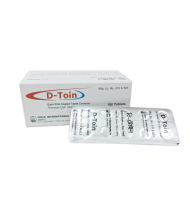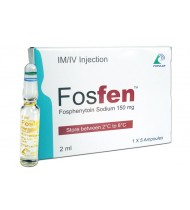Phenytoin Sodium
Indications
Parenteral Phenytoin is indicated for the treatment of generalized tonic-clonic status epilepticus, and prevention and treatment of seizures occurring during neurosurgery. Intravenous Phenytoin can also be substituted, as short-term use, for oral phenytoin. Parenteral Phenytoin should be used only when oral Phenytoin administration is not possible
Pharmacology
Phenytoin acts as an anticonvulsant by increasing efflux or decreasing influx of sodium ions across cell membranes in the motor cortex during generation of nerve impulses; thus stabilising neuronal membranes and decreasing seizure activity. It acts as an antiarrhythmic by extending the effective refractory period and suppressing ventricular pacemaker automaticity, shortening action potential in the heart.
Dosage
Oral: Epilepsy:
- Adult: Initially, 3-4 mg/kg daily as single dose or in divided doses. Alternatively, 150-300 mg daily increased gradually to 600 mg daily if necessary. Maintenance: 200-500 mg daily.
- Child: Initially, 5 mg/kg daily in 2-3 divided doses. Maintenance: 4-8 mg/kg daily in divided doses. Max dose: 300 mg daily.
- Adult: Adjunctive therapy with a benzodiazepine (e.g. diazepam): 10-15 mg/kg by slow inj or intermittent infusion at a max rate of 50 mg/min. Maintenance: 100 mg IV (or orally) given every 6-8 hr.
- Child: Neonates: 20 mg/kg as a loading dose, then 2.5-5 mg/kg bid; 1 mth-12 yr: 18 mg/kg as a loading dose, then 2.5-5 mg/kg bid; >12 yr: 18 mg/kg as a loading dose, then up to 100 mg 3-4 times daily.
Administration
Should be taken with food. When administering to patients on nasogastric or other enteral feeds, do not administer feeds 2 hr before or after a dose. Be consistent throughout therapy in relation to feed times. Do not switch dosage forms/brands w/o prior consideration.
Interaction
Effects with other sedative drugs or ethanol may be potentiated. Enhances toxic effects of paracetamol, lithium. Increased risk of osteomalacia with acetazolamide. Decreased serum levels/effects with acyclovir, antineoplastics, benzodiazeines, ciprofloxacin, CYP2C9 inducers (e.g. carbamazepine), CYP2C19 inducers (e.g. rifampin), folic acid, vigabatrin. Increased serum concentrations with allopurinol, capecitabine, cimetidine, CYP2C9 inhibitors (e.g. fluconazole), CYP2C19 inhibitors (e.g. delavirdine), disulfiram, methylphenidate, metronidazole, omeprazole, SSRI, trazodone, trimethoprim. Increases metabolism of antiarrhythmics, anticonvulsants, antipsychotics, beta-blockers, calcium channel blockers, chloramphenicol, corticosteroids, doxycycline, oestrogens, HMG-CoA reductase inhibitors, methadone, theophylline, TCAs. Decreases levels/effects of clozapine, ciclosporin, tacrolimus, CYP2B6 substrates (e.g. bupropion, selegiline), CYP2C8 substrates (e.g. amiodarone), CYP2C9 substrates (e.g. celecoxib), CYP2C19 substrates (e.g. citalopram), CYP3A4 substrates (e.g. benzodiazepines), digoxin, itraconazole, levodopa, neuromuscular-blocking agents, thyroid hormones, topiramate. Increases levels/effect of dopamine, ticlopidine. Valproic acid may displace phenytoin from binding sites; and affect phenytoin serum concentrations. Transiently increases the hypothrombinaemia response to warfarin initially, followed by an inhibition of the response.
Contraindications
Phenytoin Sodium is contraindicated in patients with:
- A history of hypersensitivity to phenytoin, its inactive ingredients, or other hydantoins
- Sinus bradycardia, sino-atrial block, second and third degree A-V block, and Adams-Stokes syndrome because of the effect of parenteral phenytoin on ventricular automaticity.
- A history of prior acute hepatotoxicity attributable to phenytoin
- Coadministration with delavirdine because of the potential for loss of virologic response and possible resistance to delavirdine or to the class of non-nucleoside reverse transcriptase inhibitors.
Side Effects
Hypersensitivity, lack of appetite, headache, dizziness, tremor, transient nervousness, insomnia, GI disturbances (e.g. nausea, vomiting, constipation), tenderness and hyperplasia of the gums, acne, hirsutism, coarsening of the facial features, rashes, osteomalacia. Phenytoin toxicity as manifested as a syndrome of cerebellar, vestibular, ocular effects, notably nystagmus, diplopia, slurred speech, and ataxia; also with mental confusion, dyskinesias, exacerbations of seizure frequency, hyperglycaemia. Solutions for inj may cause local irritation or phlebitis. Prolonged use may produce subtle effects on mental function and cognition, especially in children.
Pregnancy & Lactation
Category D: There is positive evidence of human foetal risk, but the benefits from use in pregnant women may be acceptable despite the risk (e.g., if the drug is needed in a life-threatening situation or for a serious disease for which safer drugs cannot be used or are ineffective).
Precautions & Warnings
Cardiovascular disease, e.g. sinus bradycardia, heart blocks; DM; hepatic impairment; hypoalbuminemia; porphyria; seizures (may increase frequency of petit mal seizures); debilitated patients; elderly. Caution in IV admin in hypotension, heart failure or MI, monitor BP and ECG during therapy. IV must be given slowly (too rapid admin may cause hypotension, CNS depression, cardiac arrhythmias and impaired heart conduction). Extravasation and intra-arterial admin must be avoided. Do not discontinue abruptly (may increase seizure frequency), unless safety concerns require a more rapid withdrawal. May impair ability to drive or operate machinery.
Use in Special Populations
Pediatric Use: A loading dose of 15 to 20 mg/kg of Phenytoin intravenously will usually produce serum concentrations of phenytoin within the generally accepted serum total concentrations between 10 and 20 mcg/mL (unbound phenytoin concentrations of 1 to 2 mcg/mL). Because of the increased risk of adverse cardiovascular reactions associated with rapid administration Phenytoin should be injected slowly intravenously at a rate not exceeding 1 to 3 mg/kg/min or 50 mg per minute, whichever is slower
Geriatric Use: Phenytoin clearance tends to decrease with increasing age. Lower or less frequent dosing may be required
Renal and Hepatic Impairment Or Hypoalbuminemia: The liver is the site of biotransformation. Patients with impaired liver function, elderly patients, or those who are gravely ill may show early toxicity. Because the fraction of unbound phenytoin is increased in patients with renal or hepatic disease, or in those with hypoalbuminemia, the monitoring of phenytoin serum levels should be based on the unbound fraction in those patients.
Geriatric Use: Phenytoin clearance tends to decrease with increasing age. Lower or less frequent dosing may be required
Renal and Hepatic Impairment Or Hypoalbuminemia: The liver is the site of biotransformation. Patients with impaired liver function, elderly patients, or those who are gravely ill may show early toxicity. Because the fraction of unbound phenytoin is increased in patients with renal or hepatic disease, or in those with hypoalbuminemia, the monitoring of phenytoin serum levels should be based on the unbound fraction in those patients.
Overdose Effects
The lethal dose in pediatric patients is not known. The lethal dose in adults is estimated to be 2 to 5 grams. The initial symptoms are nystagmus, ataxia, and dysarthria. Other signs are tremor, hyperreflexia, lethargy, slurred speech, blurred vision, nausea, and vomiting. The patient may become comatose and hypotensive. Death is caused by respiratory and circulatory depression.
There are marked variations among individuals with respect to phenytoin serum levels where toxicity may occur. Nystagmus, on lateral gaze, usually appears at 20 mcg/mL, ataxia at 30 mcg/mL, dysarthria and lethargy appear when the serum concentration is over 40 mcg/mL, but as high a concentration as 50 mcg/mL has been reported without evidence of toxicity. As much as 25 times the therapeutic dose has been taken to result in a serum concentration over 100 mcg/mL with complete recovery. Irreversible cerebellar dysfunction and atrophy have been reported.
Treatment: Treatment is nonspecific since there is no known antidote. The adequacy of the respiratory and circulatory systems should be carefully observed and appropriate supportive measures employed. Hemodialysis can be considered since phenytoin is not completely bound to plasma proteins. Total exchange transfusion has been used in the treatment of severe intoxication in pediatric patients. In acute overdosage the possibility of other CNS depressants, including alcohol, should be borne in mind.
There are marked variations among individuals with respect to phenytoin serum levels where toxicity may occur. Nystagmus, on lateral gaze, usually appears at 20 mcg/mL, ataxia at 30 mcg/mL, dysarthria and lethargy appear when the serum concentration is over 40 mcg/mL, but as high a concentration as 50 mcg/mL has been reported without evidence of toxicity. As much as 25 times the therapeutic dose has been taken to result in a serum concentration over 100 mcg/mL with complete recovery. Irreversible cerebellar dysfunction and atrophy have been reported.
Treatment: Treatment is nonspecific since there is no known antidote. The adequacy of the respiratory and circulatory systems should be carefully observed and appropriate supportive measures employed. Hemodialysis can be considered since phenytoin is not completely bound to plasma proteins. Total exchange transfusion has been used in the treatment of severe intoxication in pediatric patients. In acute overdosage the possibility of other CNS depressants, including alcohol, should be borne in mind.
Therapeutic Class
Adjunct anti-epileptic drugs
Storage Conditions
Intravenous: Store at room temperature of 15-30°C.
Oral:
Oral:
- Tablet/capsule: Store below 30°C. Protect from light and moisture;
- Oral suspension: Store at room temperature of 20-25°C, do not freeze, protect from light.
D-Toin Tablet 100 mg
IndicationsParenteral Phenytoin is indicated for the treatment of generalized tonic-clonic ..
3.50Tk.
Fosfen Injection 2 ml ampoule
IndicationsParenteral Phenytoin is indicated for the treatment of generalized tonic-clonic ..
70.26Tk.
Sizatoin Tablet 100 mg
IndicationsParenteral Phenytoin is indicated for the treatment of generalized tonic-clonic ..
4.00Tk.
Showing 1 to 3 of 3 (1 Pages)



